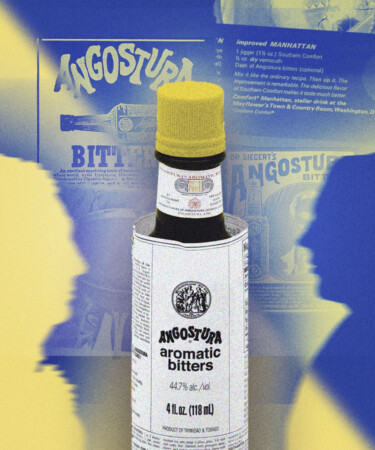Despite the pervasiveness of Angostura bitters — walk into any bar or liquor store and you’re certain to spot a slew of yellow-capped bottles — the brand’s history is shrouded in mystery. Created in 1824, the famous aromatic bitters’ recipe remains highly confidential. In fact, only five people on the planet know the recipe at a time, all of whom have made a pact never to fly together on the same plane lest the recipe be lost with them in a worst-case scenario.
In addition to the mystique regarding the ingredients used in the bitters themselves, one visual element of the bottle itself tends to throw consumers for a loop: the label. Much too large for the bottle, the Angostura label extends over the neck of the bottle and is known to bunch at the top after a few uses. “Why is this label so big?” curious cocktail makers may wonder as the paper crinkles in their hands. The answer lies in a simple miscommunication between siblings.
By the time Dr. Johann Siegert — creator of Angostura — passed away in 1870, the business had been passed onto Siegert’s sons, who relocated production from Venezuela to Trinidad and Tobago a few years later. Up until this point, the bitters had widely been regarded as a cure for digestive ailments experienced by nauseous or otherwise sick sea travelers — both Angostura and the Caribbean were hotspots for trade at the time of the bitters’ invention. To up their marketing game, the brothers devised a plan to rebrand the bottle and enter the bitters into a local competition as a means of expanding the brand’s recognition beyond that of medicinal purposes.
Rushing to complete the new packaging in time for the competition, brothers Carlos, Luis, and Alfredo were each delegated tasks as a means of saving time. One brother was tasked with creating the bottle, and another was tasked with designing the label. The only issue? They failed to discuss sizing, and the resulting two designs were completely mismatched.
Whether the bottle was made too small for the label or vice versa, the brothers soon realized that they had made a mistake — but with the competition looming, it was too late to turn back. While they may have lost the contest, they were approached by a judge who allegedly told them to keep their “signature labeling” to make Angostura stand out on the shelf, as “no one else would make this mistake.”
Today, Angostura — oversized label and all — is by far one of the most popular bitters brands in the world and an essential ingredient in classic cocktails like the Old Fashioned and the Manhattan.
